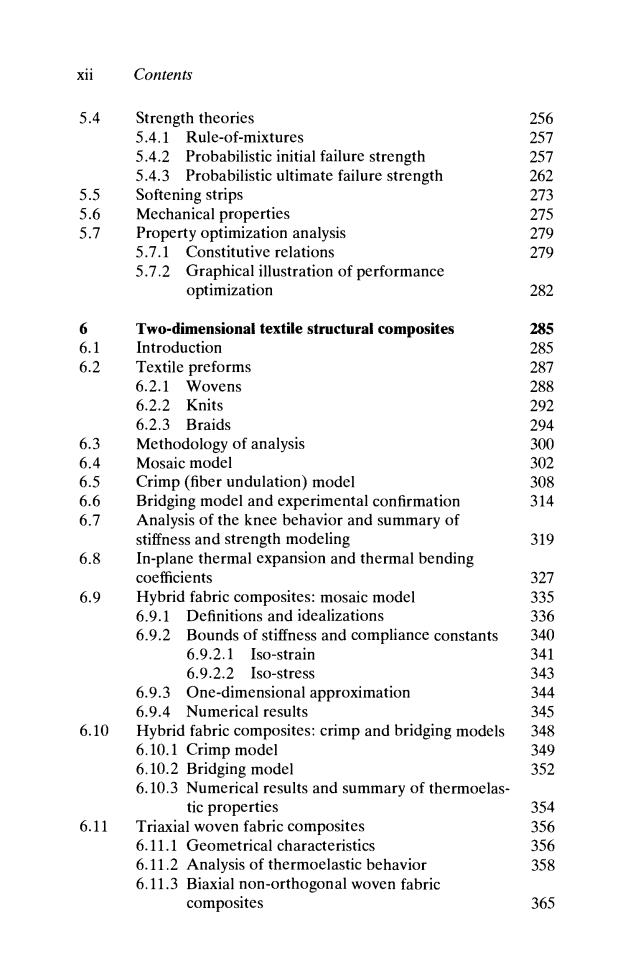正在加载图片...

xi试 Contents 5.4 Strength theories 256 5.4.1 Rule-of-mixtures 257 5.4.2 Probabilistic initial failure strength 257 5.4.3 Probabilistic ultimate failure strength 262 5.5 Softening strips 273 5.6 Mechanical properties 275 5.7 Property optimization analysis 279 5.7.1 Constitutive relations 279 5.7.2 Graphical illustration of performance optimization 282 6 Two-dimensional textile structural composites 285 6.1 Introduction 285 6.2 Textile preforms 287 6.2.1 Wovens 288 6.2.2 Knits 292 6.2.3 Braids 294 6.3 Methodology of analysis 300 6.4 Mosaic model 302 6.5 Crimp(fiber undulation)model 308 6.6 Bridging model and experimental confirmation 314 6.7 Analysis of the knee behavior and summary of stiffness and strength modeling 319 6.8 In-plane thermal expansion and thermal bending coefficients 327 6.9 Hybrid fabric composites:mosaic model 335 6.9.1 Definitions and idealizations 336 6.9.2 Bounds of stiffness and compliance constants 340 6.9.2.1 Iso-strain 341 6.9.2.2 Iso-stress 343 6.9.3 One-dimensional approximation 344 6.9.4 Numerical results 345 6.10 Hybrid fabric composites:crimp and bridging models 348 6.10.1 Crimp model 349 6.10.2 Bridging model 352 6.10.3 Numerical results and summary of thermoelas- tic properties 354 6.11 Triaxial woven fabric composites 356 6.11.1 Geometrical characteristics 356 6.11.2 Analysis of thermoelastic behavior 358 6.11.3 Biaxial non-orthogonal woven fabric composites 365xii Contents 5.4 Strength theories 256 5.4.1 Rule-of-mixtures 257 5.4.2 Probabilistic initial failure strength 257 5.4.3 Probabilistic ultimate failure strength 262 5.5 Softening strips 273 5.6 Mechanical properties 275 5.7 Property optimization analysis 279 5.7.1 Constitutive relations 279 5.7.2 Graphical illustration of performance optimization 282 6 Two-dimensional textile structural composites 285 6.1 Introduction 285 6.2 Textile preforms 287 6.2.1 Wovens 288 6.2.2 Knits 292 6.2.3 Braids 294 6.3 Methodology of analysis 300 6.4 Mosaic model 302 6.5 Crimp (fiber undulation) model 308 6.6 Bridging model and experimental confirmation 314 6.7 Analysis of the knee behavior and summary of stiffness and strength modeling 319 6.8 In-plane thermal expansion and thermal bending coefficients 327 6.9 Hybrid fabric composites: mosaic model 335 6.9.1 Definitions and idealizations 336 6.9.2 Bounds of stiffness and compliance constants 340 6.9.2.1 Iso-strain 341 6.9.2.2 Iso-stress 343 6.9.3 One-dimensional approximation 344 6.9.4 Numerical results 345 6.10 Hybrid fabric composites: crimp and bridging models 348 6.10.1 Crimp model 349 6.10.2 Bridging model 352 6.10.3 Numerical results and summary of thermoelastic properties 354 6.11 Triaxial woven fabric composites 356 6.11.1 Geometrical characteristics 356 6.11.2 Analysis of thermoelastic behavior 358 6.11.3 Biaxial non-orthogonal woven fabric composites 365